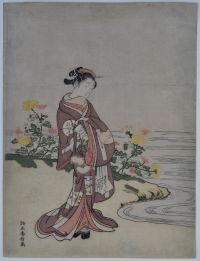1764-65 – a pivotal year for Ukiyoe-e
The years 1764/5 are now recognised as the most pivotal in the development of Ukiyo-e. Prior to this year fully polychrome prints were rarely produced. The ability to ‘key’ more than one block been known had for some time using the simple expedient of kento marks cut in relief – a right-angle in the corner, and a horizontal line down the side. However, around 1764/5, a number of favourable circumstances – namely a period of permissiveness in the arts and the proliferation of literary and poetry clubs – gave rise to the e-goyomi print (calendar-print), probably instigated by Jinshiro Tadanobu (Kikurensha Kyosen), founder of the Kikuren Club.
Calendar-prints were a government-controlled monopoly. The none-government clubs this circumnavigated by hiding the dai-sho (long and short months) numerals in various parts of a print’s design. Also, in the development of the colour print process, a tweak was made to the kento marks by the insertion of a sliver of wood; this enabled finer adjustments to be made with the keying of the blocks to compensate for expansion or contraction of the paper (or indeed the blocks). This refinement made it possible for numerous blocks to be used. The clubs commissioned the printers to use the thicker more luxurious hosho paper and a wide range of new pigments. These luxurious prints also often used over-printing and blind-printing.
Harunobu was in the right place at the right time to fully exploit these advances and the next few years would see a huge increase in Harunobu’s output, from initially designing the private e-goyomi to having them commercially sold and going on to produce a large corpus via commercial publishers. Harunobu died in 1770 but the decade saw some of the most exquisite compositions by him that were seldom surpassed in the refinement of the compositions, the palette and the printing.
Richard Kruml 2025
